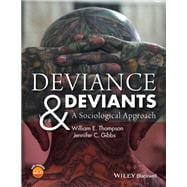This comprehensive and engaging textbook provides a fresh and sociologically-grounded examination of how deviance is constructed and defined and what it means to be classed a deviant.
- Covers an array of deviances, including sexual, physical, mental, and criminal, as well as deviances often overlooked in the literature, such as elite deviance, cyber-deviance, and deviant occupations
- Examines the popular notions and pseudoscientific explanations upon which the most pervasive myths surrounding deviance and deviants are founded
- Features an analytical through-line assessing the complex and multifaceted relationship between deviance and the media
- Enhanced with extensive pedagogical features, including a glossary of key terms, lists of specific learning outcomes in each chapter, and critical thinking questions designed to assess those outcomes
- Comprehensive instructor ancillaries include PowerPoint slides, a test bank for each chapter, instructor outlines, and sample activities and projects; a student study guide also is available








